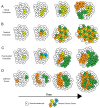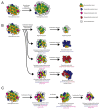Intratumor Heterogeneity in Hepatocellular Carcinoma: Challenges and Opportunities
- PMID: 34771685
- PMCID: PMC8582820
- DOI: 10.3390/cancers13215524
Intratumor Heterogeneity in Hepatocellular Carcinoma: Challenges and Opportunities
Abstract
Hepatocellular carcinoma (HCC) represents a leading cause of cancer-related death, but it remains difficult to treat. Intratumor genetic and phenotypic heterogeneity are inherent properties of breast, skin, lung, prostate, and brain tumors, and intratumor heterogeneity (ITH) helps define prognosis and therapeutic response in these cancers. Several recent studies estimate that ITH is inherent to HCC and attribute the clinical intractability of HCC to this heterogeneity. In this review, we examine the evidence for genomic, phenotypic, and tumor microenvironment ITH in HCC, with a focus on two of the top molecular drivers of HCC: β-catenin (CTNNB1) and Telomerase reverse transcriptase (TERT). We discuss the influence of ITH on HCC diagnosis, prognosis, and therapy, while highlighting the gaps in knowledge and possible future directions.
Keywords: TERT; cancer; intratumor heterogeneity; liver cancer; single-cell sequencing; therapy resistance; β-catenin.
Conflict of interest statement
The authors declare no conflict of interest.
Figures


References
Publication types
Grants and funding
LinkOut - more resources
Full Text Sources
Miscellaneous

